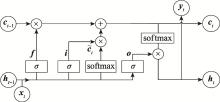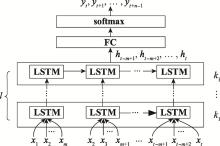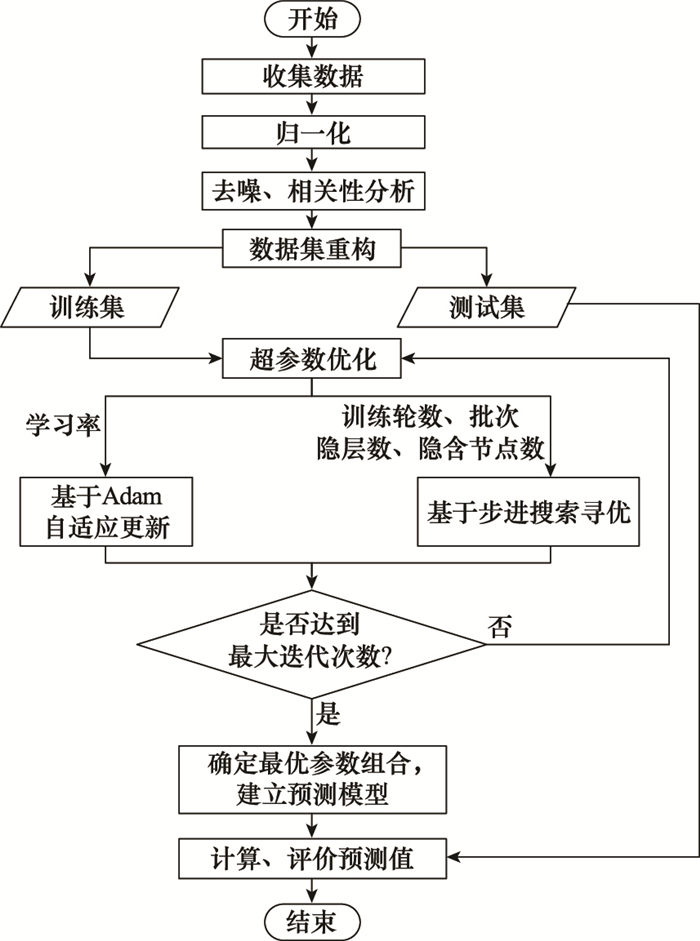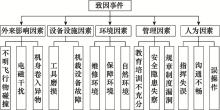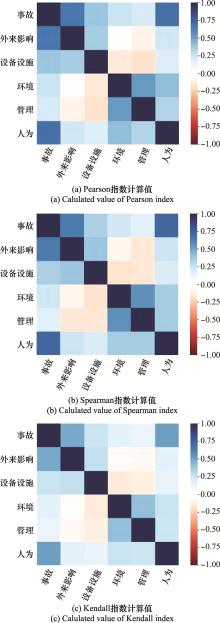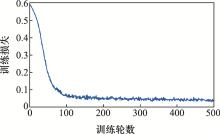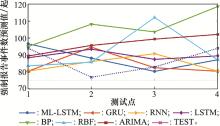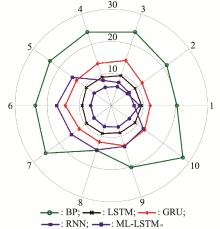Systems Engineering and Electronics ›› 2022, Vol. 44 ›› Issue (2): 569-576.doi: 10.12305/j.issn.1001-506X.2022.02.26
• Systems Engineering • Previous Articles Next Articles
Aviation safety prediction method research based on improved LSTM model
Hang ZENG1, Hongmei ZHANG1, Bo REN1,2,*, Lijie CUI1, Jiangnan WU1
- 1. Equipment Management and Unmanned Aerial Vehicle Engineering College, Air Force Engineering University, Xi'an 710051, China
2. Science and Technology on Electro-optic Control Laboratory, Luoyang 471000, China
-
Received:2021-04-06Online:2022-02-18Published:2022-02-24 -
Contact:Bo REN
CLC Number:
Cite this article
Hang ZENG, Hongmei ZHANG, Bo REN, Lijie CUI, Jiangnan WU. Aviation safety prediction method research based on improved LSTM model[J]. Systems Engineering and Electronics, 2022, 44(2): 569-576.
share this article
Table 1
Weekly statistics accident data of a certain transport aircraft"
| 周次 | 外来影响因素 | 设备设施因素 | 环境因素 | 管理因素 | 人为因素 | 强制报告事件 |
| 1 | 0.192 3 | 0.000 0 | 0.000 0 | 0.000 0 | 0.119 0 | 0.000 0 |
| 2 | 0.333 3 | 0.182 9 | 0.333 3 | 0.232 1 | 0.166 7 | 0.442 0 |
| 3 | 0.384 6 | 0.148 6 | 0.058 8 | 0.178 6 | 0.285 7 | 0.507 2 |
| ⋮ | ⋮ | ⋮ | ⋮ | ⋮ | ⋮ | ⋮ |
| 47 | 0.168 7 | 0.605 1 | 0.196 1 | 0.142 9 | 0.309 5 | 0.289 9 |
| 48 | 0.204 8 | 0.651 3 | 0.156 9 | 0.250 0 | 0.261 9 | 0.644 9 |
Table 3
Comparison of prediction accuracy under different hidden_size"
| 常变量 | 隐含节点数 | 批尺寸 | |||||
| 1 | 2 | 3 | … | 9 | 10 | ||
| 隐层数:1 步长:4 训练次数:200 | 3 | 9.852 0 | 9.167 6 | 9.003 3 | … | 8.458 0 | 8.424 9 |
| 4 | 7.876 2 | 6.832 8 | 6.757 9 | … | 6.653 4 | 6.690 6 | |
| 5 | 9.052 8 | 7.073 2 | 5.904 0 | … | 3.326 4 | 3.028 5 | |
| ⋮ | ⋮ | ⋮ | ⋮ | ⋱ | ⋮ | ⋮ | |
| 11* | 3.878 2 | 1.661 3 | 1.535 7 | … | 1.476 9 | 1.541 8 | |
| 12 | 4.699 6 | 2.464 9 | 1.459 5 | … | 1.456 7 | 1.542 7 | |
Table 4
Comparison of prediction accuracy under different layer_size"
| 常变量 | 隐层数 | 批尺寸 | |||||
| 1 | 2 | 3 | … | 9 | 10 | ||
| 步长:4 训练次数:200 | 1 | 3.878 2 | 1.661 3 | 1.535 7 | … | 1.476 9 | 1.541 8 |
| 2 | 4.027 5 | 1.481 8 | 1.271 1 | … | 1.463 7 | 1.501 0 | |
| 3 | 5.177 8 | 1.229 2** | 1.315 2 | … | 1.355 3 | 1.508 9 | |
| ⋮ | ⋮ | ⋮ | ⋮ | ⋱ | ⋮ | ⋮ | |
| 9 | 13.058 9 | 11.656 4 | 11.201 2 | … | 9.850 7 | 9.730 1 | |
| 10 | 13.893 8 | 12.335 2 | 9.787 1 | … | 6.212 8 | 6.144 7 | |
Table 5
AE of each predicted sample point"
| 模型 | 测试样本点 | |||
| 样本点1 | 样本点2 | 样本点3 | 样本点4 | |
| ML-LSTM | 0.028 4 | 0.145 4 | 0.031 2 | 0.072 1 |
| GRU | 0.143 6 | 0.229 5 | 0.005 3 | 0.143 6 |
| RNN | 0.143 4 | 0.119 0 | 0.094 3 | 0.143 4 |
| LSTM | 0.059 3 | 0.213 9 | 0.054 2 | 0.047 5 |
| BP | 0.010 9 | 0.405 0 | 0.248 7 | 0.261 4 |
| RBF | 0.110 3 | 0.114 7 | 0.350 9 | 0.073 2 |
| ARIMA | 0.048 2 | 0.243 0 | 0.197 3 | 0.086 8 |
| 1 | 国家统计局. 2010—2019年旅客周转量数据统计[EB/OL]. [2021-04-01]. https://data.stats.gov.cn/easyquery.htm?cn=C01&zb=A0G05&sj=2019. |
| 2 | DI G , PATRIARCA R , MANCINI M , et al. Overall safety performance of air traffic management system: forecasting and monitoring[J]. Safety Science, 2015, 72 (2): 351- 362. |
| 3 | LUKÁČOVÁ A, BABIČ F, PARALIČ J, et al. Building the prediction model from the aviation incident data[C]//Proc. of the IEEE 12th International Symposium on Applied Machine Intelligence and Informatics, 2014: 365-369. |
| 4 |
LI C S , CHIANG T W . Complex neurofuzzy ARIMA forecasting—a new approach using complex fuzzy sets[J]. IEEE Trans.on Fuzzy Systems, 2013, 21 (3): 567- 584.
doi: 10.1109/TFUZZ.2012.2226890 |
| 5 | 甘旭升, 端木京顺, 高建国, 等. 基于ARIMA模型的航空装备事故时序预测[J]. 中国安全科学学学报, 2012, 22 (3): 98- 102. |
| GAN X S , DUANMU J S , GAO J G , et al. Time series prediction of aviation equipment accident based on ARIMA model[J]. China Safety Science Journal, 2012, 22 (3): 98- 102. | |
| 6 |
杜毅. 基于灰色理论的飞行事故率和事故症候率预测[J]. 中国民航大学学报, 2007, 25 (6): 9- 10.
doi: 10.3969/j.issn.1001-5590.2007.06.003 |
|
DU Y . Forecast analysis of flight accident-rate or flight incident-rate[J]. Journal of Civil Aviation University of China, 2007, 25 (6): 9- 10.
doi: 10.3969/j.issn.1001-5590.2007.06.003 |
|
| 7 | 陈农田, 张宏钰, 曹玉宽. 基于灰色马尔可夫理论的进近着陆不安全事件预测[J]. 数学的实践与认识, 2020, 50 (4): 306- 314. |
| CHEN N T , ZHANG H Y , CAO Y K . Prediction of approaching landing unsafe events based on grey Markov method[J]. Mathmatics in Practice and Theory, 2020, 50 (4): 306- 314. | |
| 8 |
高建国, 端木京顺, 李闯, 等. 基于模糊均生函数和最优子集回归的飞行事故率预测[J]. 中国安全科学学报, 2011, 21 (6): 43- 47.
doi: 10.3969/j.issn.1003-3033.2011.06.007 |
|
GAO J G , DUANMU J S , LI C , et al. Prediction of flight accident rate based on fuzzy mean generating function and optimal subset regression[J]. China Safety Science Journal, 2011, 21 (6): 43- 47.
doi: 10.3969/j.issn.1003-3033.2011.06.007 |
|
| 9 |
GAO Z Y , LI J W , WANG R X , et al. Prognostics uncertainty reduction by right-time prediction of remaining useful life based on hidden Markov model and proportional hazard model[J]. Eksploatacja I Niezawodnosc-maintenance and Reliability, 2021, 23 (1): 154- 164.
doi: 10.17531/ein.2021.1.16 |
| 10 | 马春茂, 邵延君, 潘宏侠, 等. 基于灰色马尔可夫模型的装备故障间隔期预测研究[J]. 兵工学报, 2013, 34 (9): 1193- 1196. |
| MA C M , SHAO Y J , PAN H X , et al. TBF prediction of equipment based on the gray markov model[J]. Acta Armamentarii, 2013, 34 (9): 1193- 1196. | |
| 11 | ZHANG X G , MAHADEVAN S . Ensemble machine learning models for aviation incident risk prediction[J]. Decision Support Systems, 2019, 116 (1): 48- 63. |
| 12 | ROSA M A V . Prediction of aircraft safety incidents using Bayesian inference and hierarchical structures[J]. Safety Science, 2018, 104 (4): 216- 230. |
| 13 | 李大伟, 徐浩军, 胡良谋, 等. 基于支持向量机的飞行事故率预测模型[J]. 数学的实践与认识, 2009, 39 (8): 124- 128. |
| LI D W , XU H J , HU L M , et al. The prediction modelling of flight accident rate based on support vector machine[J]. Mathematics in Practice And Theory, 2009, 39 (8): 124- 128. | |
| 14 |
端木京顺, 甘旭升, 史超. 基于最小二乘支持向量机的飞行事故预测[J]. 微计算机信息, 2009, 25 (13): 285- 287.
doi: 10.3969/j.issn.1008-0570.2009.13.118 |
|
DUANMU J S , GAN X S , SHI C . Flight accident prediction based on least squares support vector machines[J]. Microcomputer Information, 2009, 25 (13): 285- 287.
doi: 10.3969/j.issn.1008-0570.2009.13.118 |
|
| 15 |
于洪霞, 李兴. 一种基于MLP神经网络的大额损失飞行事故预测模型[J]. 上海电力学院学报, 2016, 32 (5): 504- 506.
doi: 10.3969/j.issn.1006-4729.2016.05.019 |
|
YU H X , LI X . Analysis and forecast mode of major or loss flight accidents based on mlp neural networks method[J]. Journal of Shanghai University of Electric Power, 2016, 32 (5): 504- 506.
doi: 10.3969/j.issn.1006-4729.2016.05.019 |
|
| 16 |
SUNDERMEYER M , NEY H , SCHLUETER R . From feedforward to recurrent LSTM neural networks for language modeling[J]. IEEE/ACM Trans.on Audio Speech and Language Processing, 2015, 23 (3): 517- 529.
doi: 10.1109/TASLP.2015.2400218 |
| 17 |
SALAH B , ALI F , ALI O , et al. Optimal deep learning LSTM model for electric load forecasting using feature selection and genetic algorithm: comparison with machine learning approaches[J]. Energies, 2018, 11 (7): 1636- 1636.
doi: 10.3390/en11071636 |
| 18 |
GREY V H , CARLOS M , GONZALO N . A review on the long short-term memory model[J]. Artifitial Intellegence Review, 2020, 53 (8): 5929- 5955.
doi: 10.1007/s10462-020-09838-1 |
| 19 | 熊明兰, 王华伟, 徐怡, 等. 基于鸟击事故征候预测的通用航空安全研究[J]. 系统工程与电子技术, 2020, 42 (9): 2033- 2040. |
| XIONG M L , WANG H W , XU Y , et al. General aviation safety research based on prediction of bird strike symptom[J]. Systems Engineering and Electronics, 2020, 42 (9): 2033- 2040. | |
| 20 |
HOCHREITER S , SCHMIDHUBER J . Long short-term memory[J]. Nerual Computation, 1997, 9 (8): 1735- 1780.
doi: 10.1162/neco.1997.9.8.1735 |
| 21 |
YONG Z Z . Long short-term memory recurrent neural network for remaining useful life prediction of lithium-ion batteries[J]. IEEE Trans.on Vehicular Technology, 2018, 67 (7): 5695- 5705.
doi: 10.1109/TVT.2018.2805189 |
| 22 |
FISCHER T , KRAUSS C . Deep learning with long short-term memory networks for financial market predictions[J]. European Journal of Operational Research, 2018, 270 (2): 654- 669.
doi: 10.1016/j.ejor.2017.11.054 |
| 23 | LIU H , MI X W , LI Y F . Smart multi-step deep learning model for wind speed forecasting based on variational mode decomposition, singular spectrum analysis, LSTM network and ELM[J]. Energy Conversion and Management, 2018, 159 (3): 54- 64. |
| 24 | ZHAO J C , DENG F , CAI Y Y , et al. Long short-term memory-fully connected (LSTM-FC) neural network for pm2.5 concentration prediction[J]. Chemosphere, 2019, 220 (4): 486- 492. |
| 25 | ZHOU Y F , ZHANG M C , ZHU J L , et al. A randomized block-coordinate Adam online learning optimization algorithm[J]. Neural Computing & Applications, 2020, 32 (16): 12671- 12684. |
| 26 | 单磊. 深度学习算法并行优化技术及应用研究[D]. 长沙: 国防科技大学, 2019: 17-18. |
| SHAN L. Research on parallel optimizaion for deep learning algorithms and applications[D]. Changsha: National University of Defense Technology, 2019: 17-18. | |
| 27 | 薛宇敬阳. 我国通用航空飞行事故原因研究[D]. 北京: 中国矿业大学, 2019: 36-37. |
| XUEYU J Y. The study on causes of general aviation flight accidents in china[D]. Beijing: China University of Mining & Technology, 2019: 36-37. | |
| 28 |
GREFF K , SRIVASTAVA R K , KOUTNIK J . LSTM: a search space odyssey[J]. IEEE Trans.on Neural Networks and Learning Systems, 2017, 28 (10): 2222- 2232.
doi: 10.1109/TNNLS.2016.2582924 |
| 29 |
GAO L L , GUO Z , ZHANG H W , et al. Video captioning with attention-based LSTM and semantic consistency[J]. IEEE Trans.on Multimedia, 2017, 19 (9): 2045- 2055.
doi: 10.1109/TMM.2017.2729019 |
| 30 | SRIVASTAVA N , HINTON G , KRIZHEVSKY A , et al. Dropout: a simple way to prevent neural networks from overfitting[J]. Journal of Machine Learing Research, 2016, 15 (6): 1929- 1958. |
| 31 |
HUANG G B . An insight into extreme learning machines: Random neurons, random features and kernels[J]. Cognitive Computation, 2014, 6 (3): 376- 390.
doi: 10.1007/s12559-014-9255-2 |
| [1] | Shuang SONG, Yue ZHANG, Linna ZHANG, Yigang CEN, Yidong LI. Lightweight target detection algorithm based on deep learning [J]. Systems Engineering and Electronics, 2022, 44(9): 2716-2725. |
| [2] | Qian NIE, Lihua YANG, Bo HU, Lulu REN. Time-varying channel prediction method based on LSTM neural networks under basis expansion model [J]. Systems Engineering and Electronics, 2022, 44(9): 2971-2977. |
| [3] | Jian WANG, Zihao HE, Jie LIU, Ke YANG. Image fusion algorithm based on gradient domain guided filtering and improved PCNN [J]. Systems Engineering and Electronics, 2022, 44(8): 2381-2392. |
| [4] | Caiyun WANG, Yida WU, Jianing WANG, Lu MA, Huanyue ZHAO. SAR image target recognition based on combinatorial optimization convolutional neural network [J]. Systems Engineering and Electronics, 2022, 44(8): 2483-2487. |
| [5] | Guan WANG, Haizhong RU, Dali ZHANG, Guangcheng MA, Hongwei XIA. Design of intelligent control system for flexible hypersonic vehicle [J]. Systems Engineering and Electronics, 2022, 44(7): 2276-2285. |
| [6] | Cheng FAN, Buhong WANG, Jiwei TIAN. Node classification of airline network based on the graph convolution network model with multi-task learning [J]. Systems Engineering and Electronics, 2022, 44(7): 2341-2349. |
| [7] | Guodong JIN, Yuanliang XUE, Lining TAN, Jiankun XU. Advances in object tracking algorithm based on siamese network [J]. Systems Engineering and Electronics, 2022, 44(6): 1805-1822. |
| [8] | Ruiping JI, Chengyi ZHANG, Yan LIANG, Yuedong WANG. Trajectory prediction of boost-phase ballistic missile based on LSTM [J]. Systems Engineering and Electronics, 2022, 44(6): 1968-1976. |
| [9] | Zhaoguo HOU, Huawei WANG, Liang ZHOU, Qiang FU. Fault diagnosis of rotating machinery based on improved deep residual network [J]. Systems Engineering and Electronics, 2022, 44(6): 2051-2059. |
| [10] | Juan WEI, Huangwei YANG, Fangli NING. Acoustic scene classification based on joint optimization of NMF and CNN [J]. Systems Engineering and Electronics, 2022, 44(5): 1433-1438. |
| [11] | Dong CHEN, Yanwei JU. Ship object detection SAR images based on semantic segmentation [J]. Systems Engineering and Electronics, 2022, 44(4): 1195-1201. |
| [12] | Pu ZHANG, Huifeng XUE, Shan GAO, Xuan ZUO. Distributed finite-time adaptive cooperative fault-tolerant control for multi-agent systems with integrated actuators faults [J]. Systems Engineering and Electronics, 2022, 44(4): 1220-1229. |
| [13] | Yajie XU, Yong XIAN, Bangjie LI, Leliang REN, Shaopeng LI, Weilin GUO. Method for improving the precision of hypersonic vehicle inertial navigation system based on neural network [J]. Systems Engineering and Electronics, 2022, 44(4): 1301-1309. |
| [14] | Wei FANG, Yu WANG, Wenjun YAN, Chong LIN. Symbolized flight action recognition based on neural network [J]. Systems Engineering and Electronics, 2022, 44(3): 737-745. |
| [15] | Jingming SUN, Shengkang YU, Jun SUN. Pose sensitivity analysis of HRRP recognition based on deep learning [J]. Systems Engineering and Electronics, 2022, 44(3): 802-807. |
| Viewed | ||||||
|
Full text |
|
|||||
|
Abstract |
|
|||||
